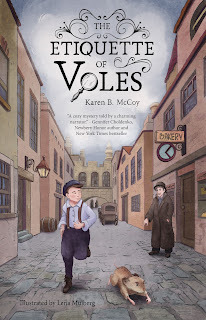Interview with Karen McCoy, Author of The Etiquette of Voles

Welcome toSmack Dab, Karen! Please tell us about TheEtiquette of Voles.
In Victorian England, a talking vole named Chains solvesmysteries to figure out why he can speak. His latest case, involving a missingshipment fish, offers some hints from his past. But someone he thought he couldtrust doesn’t want him to learn the truth, and Chains will have to decide ifknowing his origins is worth the danger it puts him in.
I was so intrigued by your decision to create Chains as atalking vole. What drew you to that animal?
Actually, it was Chains who insisted he was a vole. He cameto me fully formed, demanding to be written down. I knew right away that hisname was Chains because of Charles Darwin’s misinterpreted “missing link”theory and that he wanted to solve mysteries in order to eke out his ownorigins. The development of the plot was centered mainly on that.
I’m a lifelong animal lover, and I’m a total sucker for therelationships between animals and people. So of course I found the relationshipbetween Chains and Petunia deeply moving. How did you approach writing theconnection between a talking animal and a traumatized child?
I have always loved animals too and have found comfortthrough them for most of my life. When Petunia found her way into the story, Iknew that she and Chains would have a special connection with their sharedtrauma. My goal was to capture that feeling when you encounter someone whoreally understands what you’ve been through because they’ve walked a similarpath. I wanted Chains to find comfort with Petunia, but want to protect her aswell. Petunia really came to life during my research into The Foundling Hospitalin London (a real place). There is beauty and pain in her scars, but I alsowanted to emphasize that while they are a part of her, they don’t outrightdefine her.
Historical fiction can be so tricky, because you can godown that research rabbit hole and never emerge. What kind of research did youdo into 1890s London? How did you decide which details to include and what toleave out? Any tidbit you had to cut and want to share here?
As a librarian, research is one of my love languages. I hada wonderful time looking at old London maps, photographs, and newspapers. Iactually stumbled upon a physical newspaper at an antique store once! I collectall my research in a folder on my computer that acts as a sub-folder to thebook content itself. I have often gone back and referred to primary sourcedocuments and other research artifacts in the process of both drafting andrevising.
It was hard to know what to put in and what to leave out,because all of it was so interesting! Ultimately, I had to go with what servedthe overall story and leave out the details that were too far away from themain narrative. I think one of my favorite tidbits was learning that VictorianEngland had an issue with cloth piracy!
How did you come up with the Off-Railers organization? Didit spring from real Victorian concerns about animal experimentation?
In my research, I happened across the Billingsgate FishMarket and I was fascinated to learn more about how railroads took over a lotof the inland trade. I also had a very clear vision of a smoke stack shapedlike a train whistle, and the Off-Railers name just kind of floated into myhead from there. And yes, a lot of my research did also spring from realVictorian concerns about animal experimentation. While people at the time wereunfortunately more concerned about the overreach of science rather than animalwelfare itself, the rise of a process known as vivisection drew a lot ofattention to the issue.
Can you tell us a bit about your path to publication? Inyour acknowledgments, you mention nearly giving up during "'close, but nocigar' purgatory." What kept you going?
I’d say my publication journey has been pretty typical. Istarted by writing book reviews for a couple library-centered publications, andthen I wrote a nonfiction book chapter, and a feature article in a magazine,all before I had my first short story published. I thought for years that I wasa Young Adult author, until, very late in the process, I figured out that myvoice was much more suited for the Middle Grade space. While I have a few otherMiddle Grade books drafted and revised, The Etiquette of Voles ismy first published novel.
I got my first full manuscript from an agent in 2014 andkind of remained in that space for…a minute, all while drafting and revisingother projects. What kept me going was my writing community for sure. Therewere times I really did question whether I was good enough to do this, and theyalways reminded me that someday everything would make sense!
Every experience you have in life shapes you as a writer.What impact did being a librarian have on crafting the book?
Being a youth services selector for a public library systemreally taught me about pacing in middle grade stories, as well as what kinds ofstories kids were most interested in. It really helped me get into the rightheadspace so that my middle grade voice could be as relatable as possible.
Whatmessage do you hope young readers take away about finding their place in theworld?
That no one needs to feel like they’re invisible or thatthey don’t deserve to take up space. That fitting in and acceptance are twodifferent things. And even if you don’t “fit in” to any particular group, itdoesn’t mean you don’t deserve love and belonging. Most importantly, you have aright to be your true self, no matter what anyone else tells you.

What’s next?
I am currently writing the sequel to Etiquette of Voles! It is a lot of fun.
Where can we find you?
Website: https://karenbmccoy.com/
Facebook: https://www.facebook.com/karenmccoybooks
Instagram: @karenmccoybooks
Threads: @karemccoybooks
BlueSky: @karenbmccoy.bsky.social



